St. Louis Brewing History

Many folks know next to nothing about the two-hundred-plus-year brewing history in their hometown. Too bad. This fascinating story should interest everyone, including those who don’t consider themselves connoisseurs of beer.
Tom Schlafly – Co-Founder of The Saint Louis Brewery
The below excerpts were originally presented as part of William J. Vollmar’s Introduction to St. Louis Brews, Second Edition: The History of Brewing in the Gateway City by Henry Herbst, Don Roussin, Kevin Kious, and Stefene Russel and were reprinted with permission.
Over its long history, St. Louis has exhibited a variety of personas, including frontier outpost, fur trading center, raucous river town, gateway to the West, transportation hub, and, not least, brewing mecca. From 1809 when John Coons set up a primitive brewery on what is today the site of the Gateway Arch, to Carlos Brito’s audacious takeover of Anheuser-Busch, St. Louis has been known as a city where beer was king.
In technocentric modern America, where what is found on the Internet or heard on Larry King Live is often held to be the fount of all knowledge, many might think that beer and St. Louis means Anheuser-Busch and the Budweiser Clydesdales. That would be as far from the truth as possible. While the influence of Anheuser-Busch is critical to the history of brewing in St. Louis, there is so much more to the story than that. Over one hundred breweries have existed in and around the Mound City during the past two centuries. Many were small, obscure operations that lasted but a few years, while others grew to be national and international behemoths. All contributed to the American brewing industry and beer’s rich, vibrant history in St. Louis.

Like most American cities, the origins of brewing in St. Louis were humble: a few small, two- or three-person operations producing only a few dozen or so barrels each year to be sold in local taverns and saloons. It was not until the influx of German immigrants in the 1840s that brewing became a significant business. Among those newcomers was Adam Lemp, who introduced lager beer to St. Louis and, some contend, to the United States. Eventually, his Western Brewery would become one of the largest in the country. By 1860 there were forty breweries in St. Louis producing 200,000 barrels annually. Among the smaller of these was the Bavarian Brewery, owned by a local soap merchant named Eberhard Anheuser. In 1869 Anheuser’s son-in-law, Adolphus Busch, became his partner, forming the name that would become synonymous with beer–Anheuser-Busch.
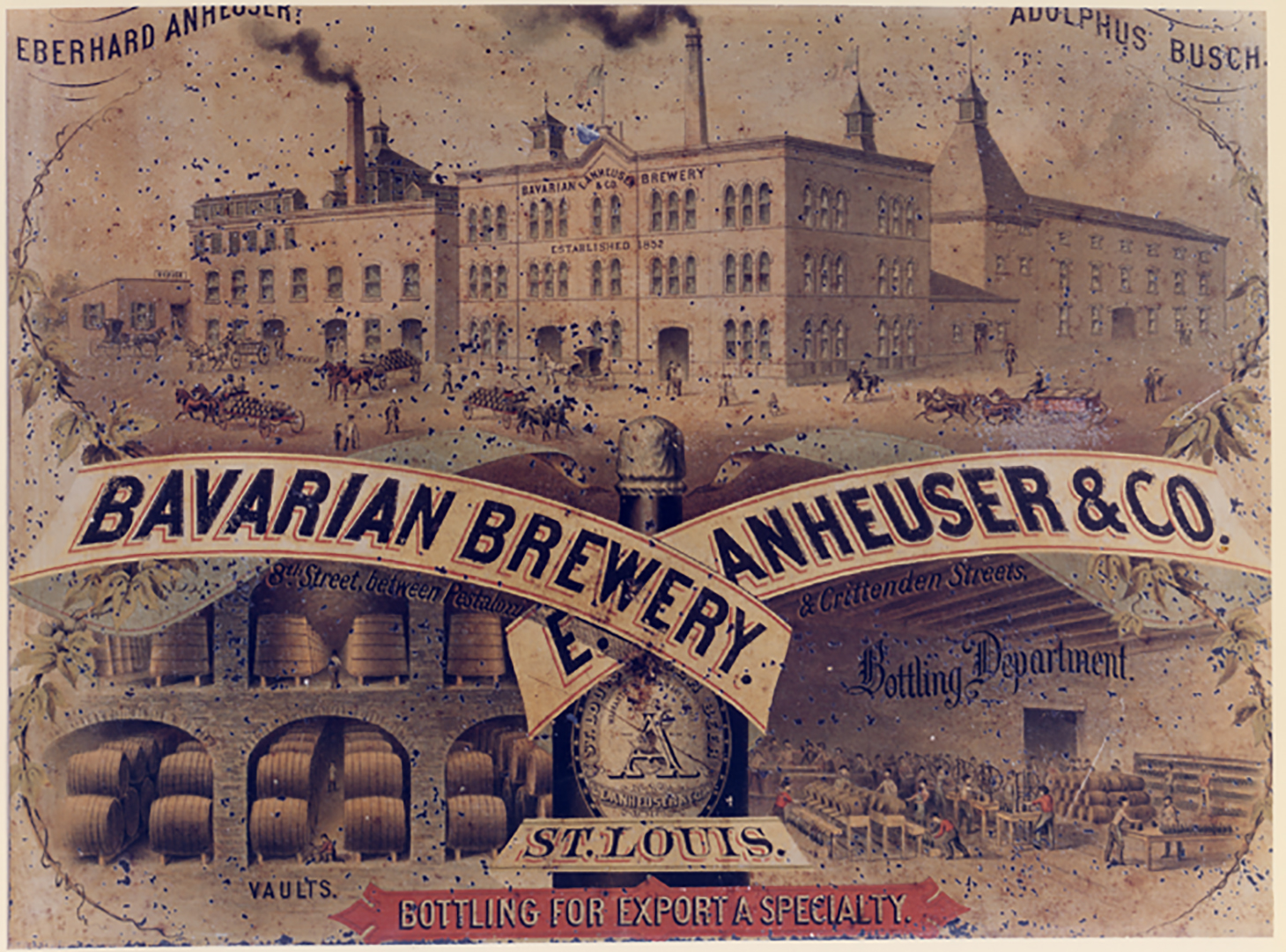
The twenty-five years following the Civil War saw a tremendous expansion of brewing in St. Louis, with the city becoming the third-largest beer producer in the country. As the Industrial Revolution took hold in America in the late 1800s, the brewing industry experienced rapid growth through technological innovations such as pasteurization, artificial refrigeration, refrigerated railcars, and a coordinated railroad distribution system. These innovations permitted breweries that were local or, at best regional in scope to transform themselves into national marketers. St. Louis breweries, led by Anheuser-Busch, were at the forefront of this transformation.
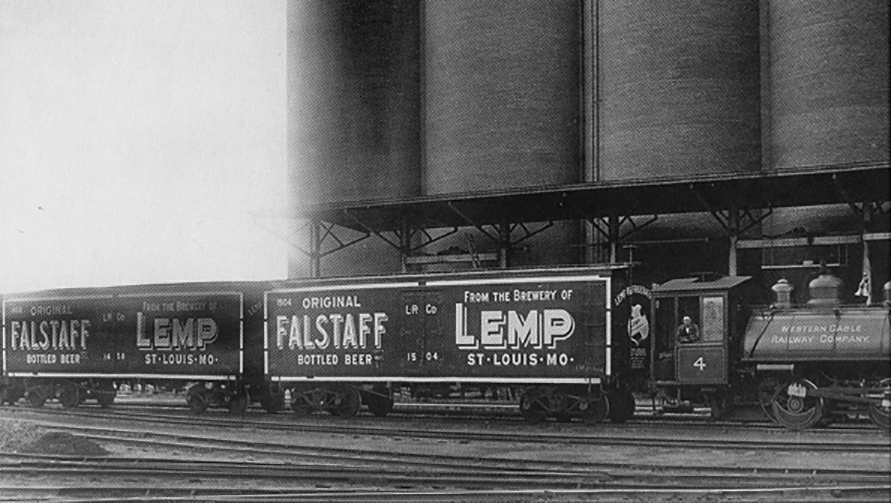
The years between 1890 and 1910 were the golden era of brewing in the United States and St. Louis. Anheuser-Busch became the world’s largest brewer. Lemp and the American Brewing Company were national brewers. The St. Louis Brewing Association, a combine of eighteen metro breweries, was in full operation and many small local breweries thrived in a city whose population had reached 687,000. But even as St. Louis brewers enjoyed their greatest prosperity, disaster was about to strike them. Within a decade, America’s favorite beverage was declared illegal, and all brewing activity in St. Louis ceased. National Prohibition existed for thirteen years. Most local brewers kept operating by producing soft drinks, baker’s yeast, ice, near beer, table syrup, and similar products.
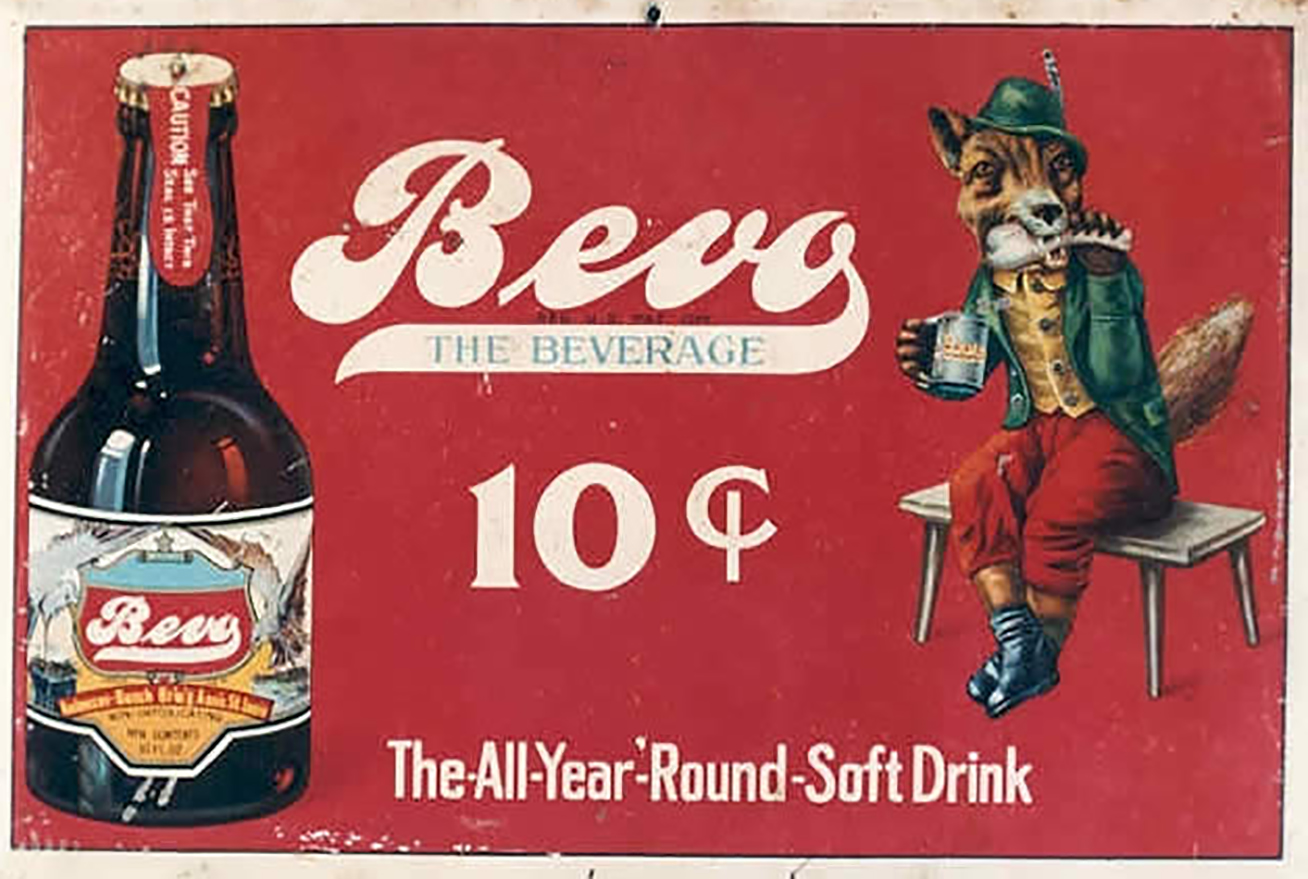
On April 7, 1933, beer was re-legalized. Twenty breweries had operated in St. Louis in 1919, but only eight reopened in 1933. Anheuser-Busch, Falstaff, and ABC were among the national brewers to return. The city’s greatest loss to Prohibition was its oldest lager brewer–the William J. Lemp Brewing Company, which closed its doors and never reopened, eventually selling its property for eight cents on the dollar.
Beer was back, but post-Prohibition brewing was nothing like it had been in its golden era. Large national brewers were beginning to dominate in a country that was ever shrinking due to radio, television, air travel, and the automobile. The small local and regional brewer, geared to deal with only his immediate market, was doomed. In 1935 America had 700 breweries; by 1950 there were less than 400; by 1970 only 125; and in 1980 a scant forty breweries produced 181 million barrels of beer. Modern business and marketing practices, combined with changing demographics, meant that only brewers who could produce and market on a massive scale could hope to prosper in a new national marketplace.
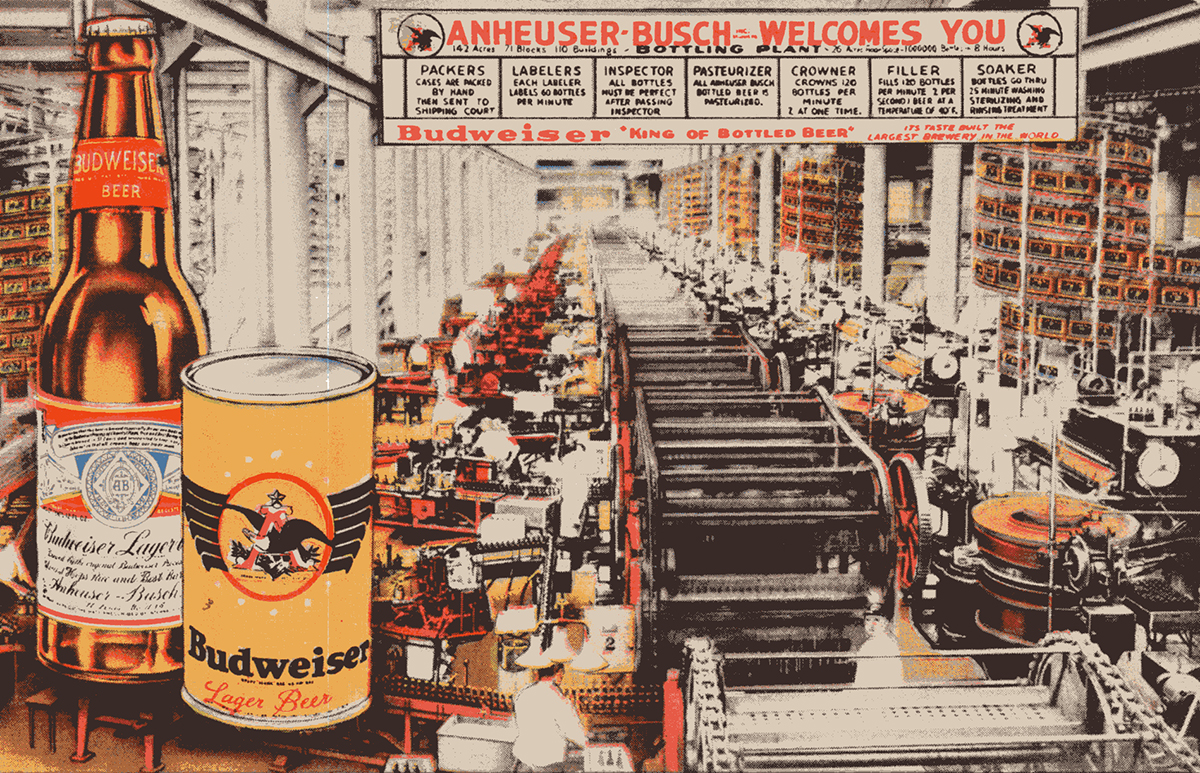
St. Louis mirrored the nation. A city that had known over one hundred breweries in its history reached a post-Prohibition high of eleven and by the mid-1950s had only two functioning plants–Anheuser-Busch and Falstaff. Both were strong national brewers, ranking third and fourth in 1948. Where Anheuser-Busch anchored its national structure on newly constructed, strategically located regional plants, Falstaff sought to fashion its power base by buying and refitting regional breweries that were going out of business. While both companies continued to grow, ranking first and third nationally in 1958, Falstaff’s base proved to be unsound. Its older facilities required major financial support and ultimately, the company began to decline in both sales and profits. In 1975, Falstaff sold out to the General Brewing Company of Corte Madera, California. On November 4, 1977, General Brewing closed the old Falstaff plant on Gravios Avenue, leaving Anheuser-Busch as the only brewery operating in St. Louis.
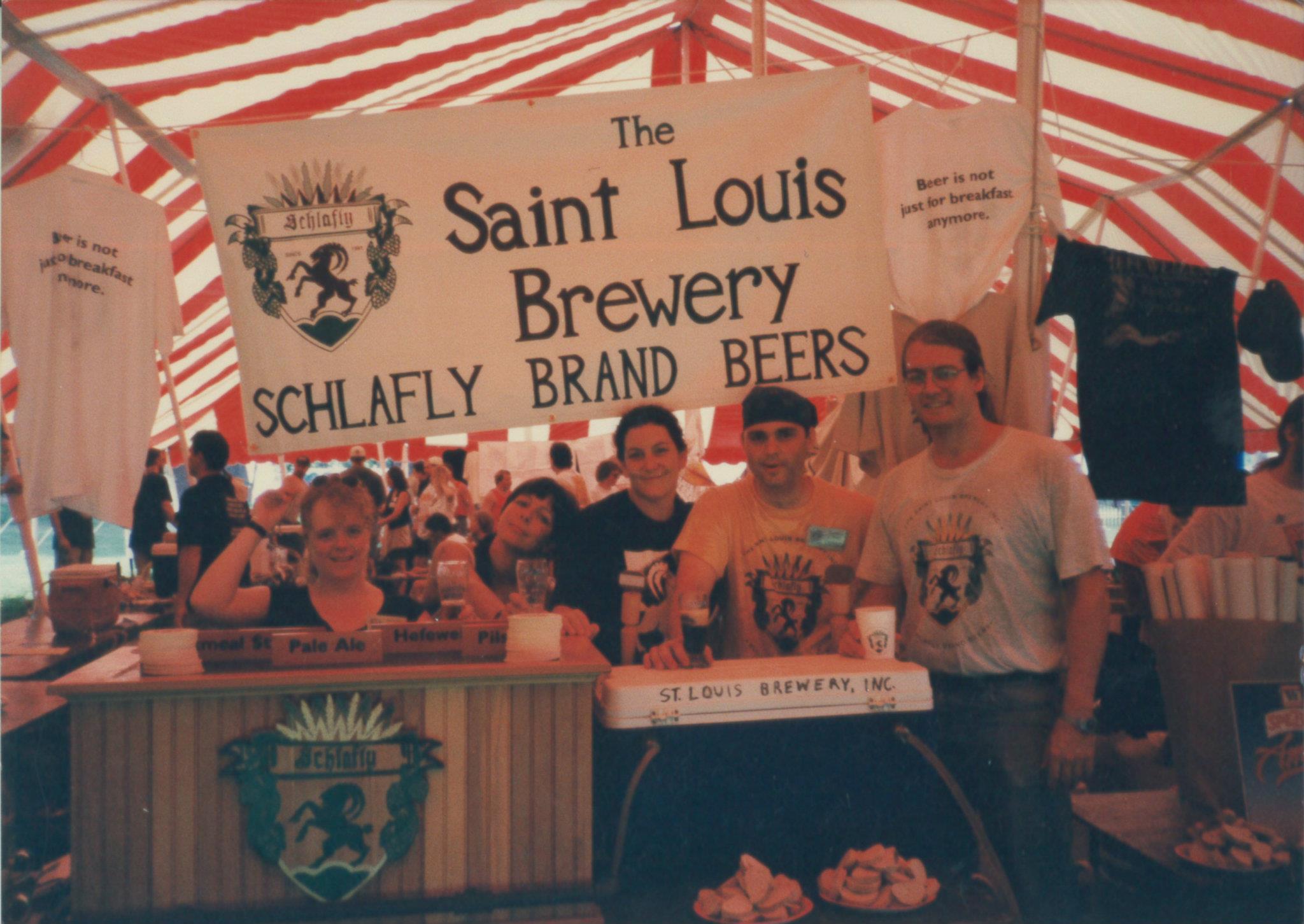
Beginning in 1991 with the opening of Tom Schlafly’s St. Louis Brewery, the city’s brewing industry began to come full circle. Over the next two decades a variety of craft breweries, brauhauses, and brewpubs opened, generally connected with an eating facility and the sale of their beer on-site. This was the full cycle–an intimate local brewery content with a smaller clientele who could be served their beer on-site, fresh and cold as it had been during brewing’s golden era. While we will not see the names of Gast, Excelsior, Hyde Park, or Green Tree again, their tradition is being carried on by Schlafly, Urban Chestnut, Civil Life, Perennial, Modern Brewery, 4 Hands, Earthbound Brewing, and dozens of others, and that can be nothing but good for St. Louis beer drinkers.
William J. Vollmar, PhD
Historian Emeritus, Anheuser-Busch
ST. LOUIS BREWING HISTORY TIMELINE
- 1809 – John Coons opens first documented primitive brewery in St. Louis on the current site of the Gateway Arch.
- 1840 – Adam Lemp credited with brewing the first lager beers produced in the United States in St. Louis.
- 1852 – George Schneider establishes the Bavarian Brewery in south St. Louis. The Bavarian Brewery would eventually become Anheuser-Busch, America’s largest brewer.
- 1860 – 40 breweries brewing a combined 212,400 barrels of beer are operating in St. Louis.
- 1876 – Adolphus Busch and Carl Conrad introduce Budweiser Beer.
- 1887 – District St. Louis of the Master Brewers Association of the Americas (MBAA) founded.
- 1889 – St.Louis Brewing Association is formed when an English business syndicate purchases eighteen of the city’s thirty breweries.
- 1904 – Adolphus Busch accepts the position of World’s Fair Director and brings together local brewers to create the fair’s largest entertainment venue, a lavish six-acre Biergarten called the German Tyrolean Alps.
- 1933 – On April 7th, the Anheuser-Busch Clydesdale Hitch makes its first public appearance delivering a case of post-prohibition Budweiser to former New York Governor Al Smith, a longtime opponent of prohibition, in front of the Empire State Building.
- 1935 – Falstaff Brewing Company of St. Louis buys the Krug Brewing Company of Omaha (Nebraska) and begins producing Falstaff beer there. This is the first time a brewery has produced its flagship brand in two cities.
- 1951 – Anheuser-Busch’s Newark (N.J.) brewery comes on line making Anheuser-Busch the first brewer to build a regional brewery outside its hometown.
- 1953 – Anheuser-Busch, maker of Budweiser beer, purchased the St. Louis Cardinals, with August “Gussie” Busch, Jr. becoming team president. Busch wanted to change the name of Sportsman’s Park to Budweiser Stadium, but the league balked at having a ballpark named after a beer. Busch instead changed the name to Busch Stadium, after which the brewery introduced Busch Bavarian Beer in 1955. Thus, instead of naming the ballpark after a beer, they tried a different tack and named a beer after the ballpark.
- 1957 – Anheuser-Busch becomes the American beer industry sales leader surpassing Schlitz and has retained that lead ever since. Its sales for 1957 were 6,116,077 barrels which amounted to 7.17% of the industry total.
- 1964 – Anheuser-Busch becomes the first brewer to produce 10 million barrels of beer in a single year.
- 1964 – Falstaff Brewing Company opens America’s first museum dedicated to beer and the American brewing industry which operated until 1975.
- 1966 – Anheuser-Busch and Falstaff Brewing Corp. are ranked #1 and #4 Top U.S. Brewers respectively brewing 13.5 million barrels and 7 million barrels.
- 1967 – Anheuser-Busch’s St.Louis brewery is declared a National Historic Landmark by the United States Department of the Interior.
- 1970 – The Brewery Collectibles Club of America (BCCA) was founded in St. Louis in April of 1970 under the name Beer Can Collectors of America. This premier breweriana collector’s club still maintains its office in Fenton, MO.
- 1975 – Final decline of Falstaff begins with Corporate HQ moving to San Francisco and mass layoffs and brewery closings. By 1990, the Falstaff brand existed as a contract brew only when the final Fort Wayne brewery is shuttered. By 2005 the brand ceased to exist altogether with only 1,468 barrels brewed in its final year.
- 1977 – Final St. Louis-based Falstaff brewery closes.
- 1986 – Anheuser-Busch breaks the billion barrel production mark since the founding of the brewery. This is the largest production of beer by a single brewer in history.
- 1991 – On December 26th, Dan Kopman and Tom Schlafly open The Saint Louis Brewery’s Schlafly Tap Room at 2100 Locust Street, the first new brewery to open in St. Louis since Prohibition.
- 1995 – Morgan Street Brewing Company opens on Laclede’s Landing.
- 1995 – St. Louis Microfest becomes the first St. Louis area beer festival.
- 2000 – O’Fallon Brewing Company opens.
- 2003 – Schlafly opens their second brewery, Schlafly Bottlewords, in Maplewood a suburb of St. Louis).
- 2006 – Square One Brewery & Distillery opens in Lafayette Park.
- 2007 – The first annual St. Louis Brewers Heritage Festival takes place May 10-12 in Forest Park, featuring beer samples from the seven existing St. Louis area breweries, Alandale Brewing Co., Anheuser-Busch, Augusta Brewing Co., Morgan Street Brewery, O’Fallon Brewery, Square One Brewery, and The Saint Louis Brewery – Schlafly Beer.
- 2008 – On July 13th, international brewing conglomerate InBev announces takeover of Anheuser-Busch. The combination of the two brewers creates the largest brewing company in the world.
- 2010 – 2nd Shift Brewing & Ferguson Brewing Company open.
- 2011 – 4 Hands Brewing Company, Perennial Artisan Ales, The Civil Life Brewing Company, Urban Chestnut Brewing Company, and Exit 6 Pub & Brewery all open.
- 2014 – Earthbound Brewing Company, Modern Brewery and Recess Brewing all open.
- 2015 – Six Mile Bridge Beer & The Old Bakery Beer both open.
- 2016 – Narrow Gauge Brewing Company opens and German brewery, Hofbräuhaus opens its largest location in Belleville, IL.
- 2017 – 8th and 9th generation members of the Griesedieck family in the brewing industry prepare to open a new Griesedieck Bros. brewery in North St. Louis.
- 2017 – Earthbound Brewery finishes construction on a new brewery on the site of the former pre-prohibition brewery, Cherokee Brewing Company.
- 2017 – Third Wheel Brewing opens in St. Peters, MO & Two Plumbers Brewing + Arcade opens in St. Charles, MO
- 2017 – Almost 60 breweries operating or in planning in the Greater St. Louis area.
- 2018 – Rockwell Beer Company opens
- 2019 – Petrichor Brewing (rebranded to Shoftleaf Brewing in 2021 opens in O’Fallon, MO
- 2020 – St. Charles’ Trailhead Brewing Co. announces closure and is acquired by Schlafly to become the third Schlafly location, Schlafly Bankside.
- 2021 – Schlafly expands with its first Illinois Brewpub, located in Highland, Illinois. Schlafly Founding brewer Steven Hale announces retirement.
- 2021 – Rockwell Beer Garden opens in St. Louis’ Francis Park & Crossroads Brewery opens in O’Fallon, MO.
- 2022 – After nearly 30 years, Schlafly Founding Brewer, Steven Hale, announces retirement.
- 2022 – Modern Brewery relocates taproom into a larger facility, Shoehorn Brewing opens in Belleville, IL
- 2023 – Alpha Brewing announces its second location, Alpha Brewing Company & Distillery
- 2023 – Mississippi Culture, Blue Jay Brewing, & Busch Family Brewing and Distilling all open, while Two Plumbers Brewing + Arcade relocate into new larger facility.
- 2023 – Alpha Brewing opens its second location, Alpha Brewing Company & Distillery


